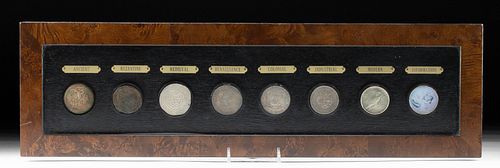Framed Ancient to Information Age Currency Coins (8)
Lot 86
About Seller
Artemis Gallery
686 S Taylor Ave, Ste 106
Louisville, CO 80027
United States
Selling antiquities, ancient and ethnographic art online since 1993, Artemis Gallery specializes in Classical Antiquities (Egyptian, Greek, Roman, Near Eastern), Asian, Pre-Columbian, African / Tribal / Oceanographic art. Our extensive inventory includes pottery, stone, metal, wood, glass and textil...Read more
Categories
Estimate:
$4,000 - $6,000
Absentee vs Live bid
Two ways to bid:
- Leave a max absentee bid and the platform will bid on your behalf up to your maximum bid during the live auction.
- Bid live during the auction and your bids will be submitted real-time to the auctioneer.
Bid Increments
| Price | Bid Increment |
|---|---|
| $0 | $25 |
| $300 | $50 |
| $1,000 | $100 |
| $2,000 | $250 |
| $5,000 | $500 |
| $10,000 | $1,000 |
| $20,000 | $2,500 |
| $50,000 | $5,000 |
| $100,000 | $10,000 |
| $200,000 | $20,000 |
About Auction
By Artemis Gallery
Oct 7, 2021
Set Reminder
2021-10-07 10:00:00
2021-10-07 10:00:00
America/New_York
Bidsquare
Bidsquare : Exceptional Antiquities Ethnographic Fine Art
https://www.bidsquare.com/auctions/artemis-gallery/exceptional-antiquities-ethnographic-fine-art-7537
Museum-worthy examples of Egyptian, Greek, Roman, Etruscan, Near Eastern, Far East / Asian, Pre-Columbian, African / Tribal, Oceanic, Native American, Spanish Colonial, Fossils, Ancient Jewelry, Fine / Visual Arts, so much more! Artemis Gallery info@artemisgallery.com
Museum-worthy examples of Egyptian, Greek, Roman, Etruscan, Near Eastern, Far East / Asian, Pre-Columbian, African / Tribal, Oceanic, Native American, Spanish Colonial, Fossils, Ancient Jewelry, Fine / Visual Arts, so much more! Artemis Gallery info@artemisgallery.com
- Lot Description
Greek, Ptolemaic Kingdom, ca. 221 to 205 BCE; Near East, Byzantine Empire, ca. 527 to 565 CE; Western Europe, Medieval period, ca. 10th to 13th century CE; Western Europe, Germany, ca. 1581 CE; Latin America, Mexico, ca. 1762 CE; East Asia, Japan, Meiji period, ca. late 19th century CE; North America, United States, ca. 1922 CE; North America, Saint Thomas, ca. 1998 CE. This collection is an interesting display of how coins have changed throughout the ages, and yet across cultures and time, they still retain recognizable elements that are still used in today's currency. Despite our modern digital wallets and cards, there is something very satisfying about real, tangible currency. For a description of each coin, please see below. These coins are professionally mounted in a wood and glass frame with engraved brass plaques with the time period, and a metal bracket on the back, and are ready to be displayed. Size of each approximately: 1.5" Diameter (3.8 cm); frame: 24" L x 7" W (61 cm x 17.8 cm)
In order of time periods on plaques, left to right: Ancient: A Ptolemaic kingdom, Ptolemy IV AE 40 bronze drachm coin with the obverse side displaying Head of Zeus Ammon facing right. Byzantine: A silver Byzantine Empire AE Follis Justinian Cyzicus with the obverse of helmeted & facing cuirassed bust of Justinian, holding a globus cruciger and shield, cross in right field. Medieval: A large silver coin the reverse face of a cross within concentric circles. Renaissance: German Electorate of Saxony Albertine Line Augustus silver thaler, 1581 Leipzig, with the obverse of armored portrait to the right with sword and lettering: "AVGVSTVS*D.G.DVX*SAXO*SA*ROMA*IMP." Colonial: A silver Mexican 8 Reales Carlos III with the reverse of crowned hemispheres flanked by crowned pillars and lettering: "VTRAQUE VNUM PLUS VLTR Mo 1762 Mo." Industrial: Japan, 1 Yen, Meiji period with obverse of dragon within beaded circle, legends above, written value below and lettering: (Japanese characters) 416 ONE YEN 900. Modern: A United States of America 1922 silver Peace Dollar with the reverse of an eagle with lettering: "UNITED STATES OF AMERICA; E PLURIBUS UNUM ONE DOLLAR PEACE." Information Age: Saint Thomas 1998 Commemorative 1000 dobras with the reverse of holographic fish and coral.
This piece has been searched against the Art Loss Register database and has been cleared. The Art Loss Register maintains the world's largest database of stolen art, collectibles, and antiques.
Provenance: ex-private Anchorage, Alaska, USA collection
All items legal to buy/sell under U.S. Statute covering cultural patrimony Code 2600, CHAPTER 14, and are guaranteed to be as described or your money back.
A Certificate of Authenticity will accompany all winning bids.
PLEASE NOTE: Due to recent increases of shipments being seized by Australian & German customs (even for items with pre-UNESCO provenance), we will no longer ship most antiquities and ancient Chinese art to Australia & Germany. For categories of items that are acceptable to ship to Australia or Germany, please contact us directly or work with your local customs brokerage firm.
Display stands not described as included/custom in the item description are for photography purposes only and will not be included with the item upon shipping.
#166750Coins are fine or more with patina and softening of details with chips to edges. Professionally mounted and displayed in modern wood and glass frame with engraved plaques. Back of frame is tightly attached to front with screws, possibly removable.Condition
- Shipping Info
-
All shipping is handled in-house for your convenience. Your invoice from Artemis Gallery will include shipping calculation instructions. If in doubt, please inquire BEFORE bidding for estimated shipping costs for individual items.
-
- Buyer's Premium



 EUR
EUR CAD
CAD AUD
AUD GBP
GBP MXN
MXN HKD
HKD CNY
CNY MYR
MYR SEK
SEK SGD
SGD CHF
CHF THB
THB














